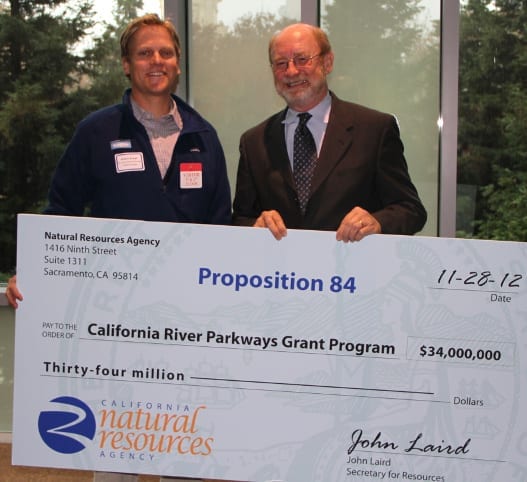CalTrout Awarded $650,000 Grant To Restore California’s Iconic Hat Creek Fishery
Hat Creek restoration funded, work set to begin in 2013
California’s once-productive Hat Creek fishery has suffered the last two decades, and while we outlined the issues and our hopes for restoration in this prior article (and this video), we’re happy to announce those hopes are on the verge of becoming reality.
CalTrout was recently awarded a $650,000 grant by the California Natural Resources Agency to restore fish habitat and create new recreational opportunities on Hat Creek.

Drew Braugh, Conservation Manager of CalTrout’s Mt. Shasta office accepts a check from John Laird.
While some of the funds will be used to improve access, the grant is aimed at improving Hat Creek’s habitat and restoring its once-sizable native fish populations.
“The slow deterioration of conditions in Hat Creek brought on by a combination of unrelated issues, including cattle grazing and burrowing by non-native muskrats, have created crisis conditions for trout,” said Drew Braugh, Conservation Manager of California Trout’s Mt. Shasta Regional Office. “The funds secured today will go a long way toward creating habitat in which these native fish can thrive.”
Recent studies suggest Hat Creek still has the ability to produce big trout, but the lack of cover and habitat makes those populations vulnerable.
CalTrout outlined a preliminary recovery plan in an earlier article, and while we’re finalizing the restoration plans, depositing large woody debris in Hat Creek — to slow flows, provide cover for bugs and fish, and promote the growth of aquatic vegetation — is still central to the recovery of Hat Creek’s native rainbow trout, which used to be supported by massive aquatic weedbeds and invertebrate populations.
In addition to financial support from the Natural Resources Agency, California Trout has worked closely with PG&E, which owns the land, the California Department of Fish and Game, and the UC Davis Center for Watershed Sciences to develop and implement a feasible and scientifically sound restoration plan for Hat Creek.
“Hat Creek is truly at the heart of our mission to protect and restore wild trout and their waters,” said California Trout Executive Director Jeff Thompson. “We have brought wild trout populations back from dire straits in this creek before, and we can do it again.”
We’re excited. This grant represents the fruition of a lot of hard work on the part of CalTrout staff. And we’re sure that — for Hat Creek and California’s fishermen — the best is yet to come.
We’ll provide you with more information about Hat Creek’s restoration as it becomes available.





9 Comments
This makes my heart ” soar like hawk” as I remember Hat Creek in the “glory days ” . Recent visits have been all but de -moralizing…. I would be glad to volunteer for any physical work to be done…plant trees … Dig holes….what ever it takes…thanks for all of your work on behalf of wild trout and all the environments that support it…….
I really hope that this is efficacious. Seems the last restoration was putting trees in the creek, and look where we are at. To me, Hat has bigger and more rainbow in recent years, and the big browns have all but disppeared—probably due to the changes. To my way of thinking, much of the problem is the pounding the riffle below the power house gets from bobber fishermen. Why not eliminate the use of indicators and lead? This would spread out fishermen. I believe Hat is just fine, and the problem people are having is: it is one of the hardest steams in the US. A great night for me is two or three fish landed. These fish are tough—even when hooked they are as hard to land as tarpon. They come unbuttoned like all fish in catch and release streams, but who cares? We are releasing them, no?
I’ve fished there for over thirty years, and i do not think it’s broke.
rl
I agree with Roger L.. I’ve fished Hat Creek twice, once “nada’, the second time a 16″ wild rainbow and that one fish made my day. A 16″ bow from the ‘riffle”, what more could you want?. If you caught 5/6 fish that size at a time what would the appreciation of that water be? Tom
My Grandpa taught me how to fish at Hat Creek (in early 70’s) We went every summer since i was 7 years old, I caught my “limit” once and had to clean them all. HAT CREEK holds wonderful memories, happy to hear it may bring great experiences to other kids. Thank you CalTrout
I was watching a YouTube video a couple weeks ago; it was a falconer that had acquired a mink, and trained it to fish and hunt muskrats. I immediately thought of Hat Creek (not the fish part!), and forwarded it to my dad. That was based on my memories of walking along the streambank over a decade ago.
Mink muskrat hunting.
Interesting. I wonder what impacts a mink population would have.
I think a population could endanger the fish more than the current muskrats (they also like to eat fish)–but could allowing trained mink supervised hunting reduce the muskrat population without creating a new problem?
Not sure how DFG would view a trained mink being brought into the region. The video I watched was posted by a falconer that was interested in the species–a lot more dedication and training than a pet owner.